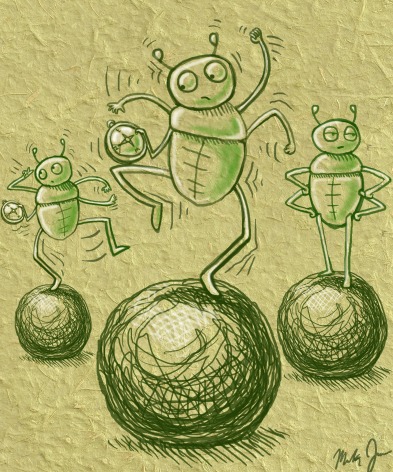Dung – one of the favorite hangouts for many beetles. Perhaps some of the most iconic beetles are associated with dung as they roll pieces of it into a ball and push it across the landscape. The beetles that perform this behavior are the scarabs (family Scarabaeidae) and they use their little ball of dung as a food source, a nursery for their beetle eggs, or as a persuasive gift from the males to win over the ladies. Not all scarabs do this though. Many of them dig directly below the dung and use it right then and there. The rolling behavior is thought to have evolved in response to competition for the dung. When a beetle finds a pile of dung, it’s akin to the shopping intensity of a black Friday – “Today only! All dung must go!”
Once the beetle has his ball of dung, he gets on top of it and does a little “dance”, circling around the top of it. Then he dismounts from atop the dung ball and rolls it away from the source as quickly as possible. But why does he dance? Ants in his pants?
The authors of a recent paper hypothesized that the “dancing” behavior is the way that the beetle orients himself so that he can move away from the dung pile. One of the really interesting things about these beetles is that they follow a straight line away from the dung once they have their ball. Which is pretty impressive if you consider the size of a beetle and the possibly rough terrain they have to travel over. They have to get away from the main dung source as quickly as possible because other scarab beetles will steal their ball rather than making one themselves. The researchers tested their hypothesis by basically making obstacle courses for the beetles to go through. The beetles were forced to run into a door, they went into a tunnel where there was a small drop, they were also placed on a table and spun around 180 degrees. The researchers wanted to see if the beetles would “dance” during each of these scenarios to reorient themselves after the obstacle.
And dance they did! It appears that the “dance” is used to establish a sort of orientation compass for the beetles. When disturbed on their path, they need to dance again for re-orientation. Interestingly though, they don’t all dance. Even initially at the dung pile, 39% of the beetles didn’t dance. And when they were spun around 180 degrees, 52% of them didn’t dance. What’s going on with these little beetles that refuse to participate? Are these non-dancing beetles at a disadvantage to the dancers? Or are they just more subtle dancers? You know, maybe they’re the quiet toe-tappers of the species. Well, it remains to be seen, but the researchers will be focusing on these “party poopers” for their next project.
You can see video footage of the beetles dancing and the experimental set-ups here (http://www.youtube.com/user/LundVisionGroup/videos)
Baird E, Byrne MJ, Smolka J, Warrant EJ, Dacke M. (2012) The dung beetle dance: An orientation behavior? Plos One, 7(1): e30211.

One thought on “dancing dung beetles”